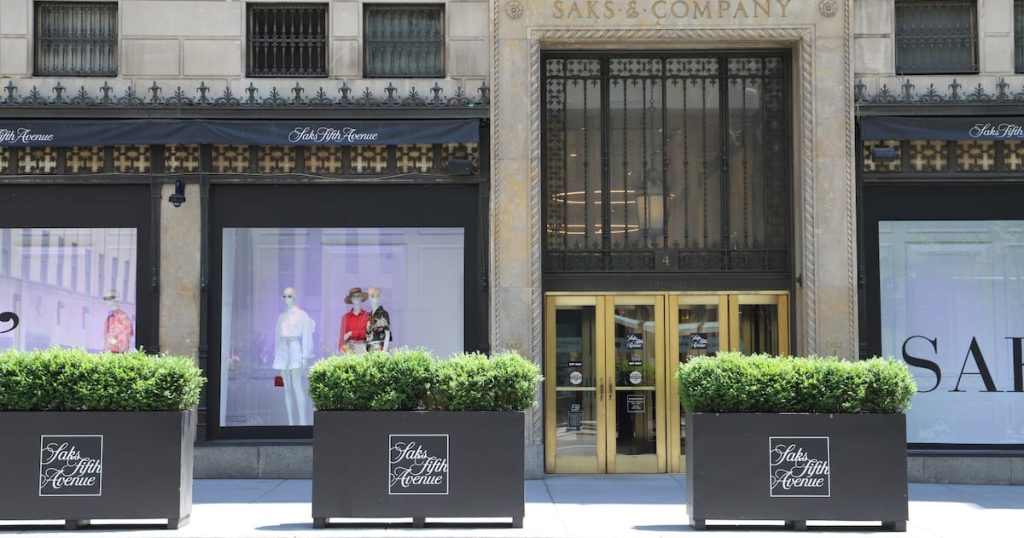
If Saks Global intended to extend an olive branch by promising to make whole 2,000-odd brands on long-delayed payments, the strategy appears to have backfired.
In a Feb. 14 letter sent to vendors working with Saks Fifth Avenue, Neiman Marcus and Bergdorf Goodman department stores, chief executive Marc Metrick acknowledged Saks’ history of late payments for merchandise, laid out a plan to resolve missed or partial payments by the middle of next year and promised to pay invoices for new orders within 90 days of receiving inventory.
But the email has touched a raw nerve with many of its recipients. Four brands told BoF this week that they will no longer work with Saks, Neiman Marcus and Bergdorf Goodman, and others said they plan to reduce their business with the department stores after receiving the letter.
“We were hoping to grow our business with Neiman this year, but after the acquisition, it looks like that won’t be happening,” said the founder of a Los Angeles-based contemporary brand. “It’s just too much of a risk right now.”
Others put their reactions in stronger terms. “It is so arrogant and disrespectful,” one executive at a New York-based fashion brand wrote to BoF.
The letter, and its negative reception, lays bare the challenges ahead both for Saks and the many brands whose businesses depend on wholesale. Saks needs vendors’ goodwill — and their best products — if it is to fulfill its ambitions of becoming the leading force in American luxury retail. For their part, brands fear they can’t walk away from what is one of their biggest sales channels, but also worry about the financial impact of the irregular flow of payments from Saks.
In an interview with The Business of Fashion, Metrick acknowledged that the late payments were not fair to Saks Global’s brand partners, and that his memo was intended to set the foundation for a new era of growth for the company. He said Saks itself has also faced rising costs as it navigates a troubled wholesale market and declining luxury market, which has caused the company to run through capital faster than anticipated.
“The model doesn’t work,” Metrick told BoF. “You can take cash in but you’re paying people fast and building beautiful shops and the price of advertising has doubled … The amount of competition has increased, the verticalisation of the brands themselves opening their own stores has increased.”
But he also had a message for brands threatening to walk away.
“For a year and a half I heard, ‘We just need clarity,’” Metrick said. “And so I sent a letter and I said here’s what’s going on. But I have a business to run. Customers to satisfy … If this is not enough clarity, or if you don’t like this, then tell me so I can fill your space with other stuff.”
Deteriorating Relations
Ties between Saks Fifth Avenue and its vendors began deteriorating in early 2023, when brands began noticing a pattern of late or withheld payments. The department store chain, owned by Hudson’s Bay Company (now known as HBC), had been a reliable partner up to that point, vendor sources said.
Some brands, including the LA-based label, ended or scaled back their relationships with Saks. But many others hoped the irregular payments were a temporary hiccup, or that Saks was hoarding cash while it plotted its long-rumoured takeover of Neiman Marcus Group. That deal, which was announced in July 2024 and completed in December, was accompanied by the issuance of a $2 billion bond and buy-in from some deep-pocketed investors, including Amazon, Authentic Brands Group and Salesforce.
The deal did little to speed up the trickle of payments, however. Metrick and Richard Baker, executive chairman of HBC, hosted a conference call with vendors last August apologising for the late payments and assured them the retailer would be more transparent after the Neiman Marcus transaction goes through.
“I understand and am sympathetic to the last 18 months and the challenges regarding payments,” Metrick reiterated in the letter last week.
While the text of the letter promises payment in full, for many recipients, it appears it was too little too late.
“It’s wrong and misleading to act as if this is going to be helpful,” said the CEO of an American fashion group who decided last week to terminate its relationship with Saks for good and cancelled its upcoming orders from Neiman Marcus and Bergdorf Goodman. “It’s disrespectful to say everyone should put the last 18 months behind them, when Saks had their buyers go out in the market and commit to orders that they had no intentions of seeing through.”
Other brands are taking the letter in stride. So-called net 90 payment terms are not unusual in the wholesale business, and Saks is hardly the first department store to defer payments. Purchase orders are rarely contractual, and as unsecured creditors, brands have always had limited means of collecting what’s owed to them by their stockists.
“It’s still going to be a lot of chasing but at least it’s something,” said one LA-based designer. “I was ready to write off what they owed us as bad debt.”
Gary Wassner, founder of leading fashion-financing firm Hildun, told his clients to give Saks the benefit of doubt. “Nobody is going to lose any money as they did with Barneys and Neiman when they went bankrupt, or as they did with Matchesfashion,” Wassner told BoF. “Nobody from Saks is trying to negotiate down the amount they’re owed. Saks has clearly said they will pay everyone. That’s one comforting aspect of the situation.”
But given Saks’ recent track record, even net 90 seems like an unreliable promise, one CEO said.
“Everyone knows they’ll play games around that,” they said.
Some also took issue with what they called a thinly veiled threat in Metrick’s letter, which stated that if brands choose to cut back their shipments to Saks, then they would be eliminated from its brand roster.
“In the absence of the normal flow of goods, we anticipate that we will have to make changes to our brand partner matrix,” Metrick wrote.
He told BoF stocking a smaller number of brands would help Saks Global better support the ones that remain, whether that’s better real estate in stores and online or a deep enough buy and attention from staff.
“To do that, you can’t do business with thousands of brands,” he said.
What’s the Plan?
Even if the company starts paying back the millions of dollars it owes vendors, executives who spoke with BoF said they question whether Saks Global can make good on its promise to become the dominant force in luxury retail that was touted as the reason for the merger.
“We took a big leap to get this deal done, but we did it so we can strengthen not just our company but strengthen our ability to be a great partner and to grow the industry,” said Metrick.
However, that task will only grow more difficult if Saks cannot mend its relationship with the brands that fill its stores. Several brand executives noted that Saks’ approach to paying vendors had spread to Neiman Marcus and Bergdorf Goodman. Prior to the transaction closing, the Neiman Marcus Group-owned stores were responsible partners that usually paid their bills 30 days after an invoice went through, some brands said.
“What I see is a lack of vision, a lack of integrity and, frankly, a lack of a business plan,” said the CEO of the American fashion group that ended its relationship with Saks.
The anger among vendors has been exacerbated by word-of-mouth reports that brands with personal connections to Saks leadership, or under the ownership of powerful conglomerates, have had fewer hiccups with payments, and have been told by the company that they will not be subject to the payment plan outlined in the letter. Metrick confirmed that there are some vendors who are exempt from the new plan.
“Terms are based on individual brand negotiations, [so] some brands would have different terms than other brands,” he said.
Can’t Walk Away
Despite their frustration, industry insiders were reluctant to speak on the record about Saks because of its sheer scale and its connections to other powerful figures in the business. Saks Fifth Avenue and Neiman Marcus Group combined have annual turnover of $10 billion. Though they have competitors that stock a similar assortment, as far as US-based, pure luxury department store chains go, it’s the biggest game in town.
“None of us are able to speak out about this because we do not hold the power — Saks does,” said one designer of a small New York-based fashion brand who was owed $100,000 by Saks Fifth Avenue last year. Saks has since paid most of that total, but the designer decided to exit the retailer about six months ago and is now weighing whether to do the same with Neiman Marcus and Bergdorf Goodman.
For smaller brands, even a $10,000 missing payment can lead to severe cash flow issues and upend their production schedule, destabilising their businesses. The designer who was owed $100,000 told BoF that after Saks stopped paying its bills, they had to take out a commercial bank loan for the first time.
Alternatives to working with Saks are scarce. All of the brands BoF spoke to for this story said they have adjusted their sales and shipments to Saks since 2023, when the payment issues first surfaced. By prioritising their direct-to-consumer channels, brands can reduce the financial impact of wholesale debt.
“This reinforces what we knew was happening: that you can’t put all your eggs in one basket,” said the founder of the LA-based contemporary brand. “You have to diversify and be able to stand alone as a brand.”
But there are limits to how far a direct selling strategy can go; the e-commerce marketplace is crowded, and online marketing is expensive, as is opening directly-operated brick-and-mortar stores.
“You’d imagine brands would be happy to shift time and money into their own channels,” said Eric Fisch, national sector head of retail and apparel at HSBC’s corporate banking division. “But we are seeing a lot of brands spend time with wholesale partners.”
Another way to make up for late payments is to charge Saks higher prices, which can lead to thicker margins on the products the retailer does end up selling. This was standard practice among vendors for Sears and JCPenney leading up to their respective bankruptcies. It can be effective for brands, but will weaken the retailer.
“That whole dynamic is what’s wrong here,” the designer who was owed $100,000 said.
What Happens Now?
On that, the brands and Metrick agree.
“I’m not a victim of it but at the same time, I’m an equal participant in the ecosystem,” Metrick said.
For Saks Global, the way to address wholesale’s systematic problems is to “create the largest, most highly personalised, best customer experience that you can have, channel agnostic,” he said.
Under the leadership of Richard Baker, the chairman of Saks Global-owner HBC, Saks’ own retail footprint has been scaled back in recent years. Baker, a real estate investor, has amassed a fortune buying and selling off retail properties. Under Baker’s ownership, Lord & Taylor sold its flagship store in Manhattan for $850 million in 2017, three years before it declared bankruptcy.
Earlier this week, it was reported that Saks Global will close the Neiman Marcus flagship store in downtown Dallas next month, as well as a Saks Fifth Avenue flagship location in Toronto. Saks has not confirmed the latter, and told BoF that the Dallas closure was due to failed lease negotiations with a landlord.
However, Metrick said Saks Global’s future lies in retail, not real estate.
“You don’t double down on luxury retail to build the largest luxury multi-brand distribution platform in the world, because you’re just interested in real estate,” Metrick said. “Luxury is our long game, and we are steadfastly committed to our strategy.”
Saks faces plenty of competition on that front. There are a growing number of specialty stores with strong regional followings, and nationwide chains that dabble in high-end fashion and accessories, such as Anthropologie. Online retailers including Shopbop, Revolve and FRWD have built reputations in recent years as supportive and high-volume partners.
Saks’ straining relationship with brands will also be an opportunity for Nordstrom and Bloomgindales to enhance their brand mix and product assortment, insiders said. Even Macy’s is exploring an upmarket play in certain locations and has inked new partnerships with a number of contemporary brands.
“Whenever there is disruption in one retailer or channel, it always creates opportunities with best-in-class competitors,” said Fisch.








